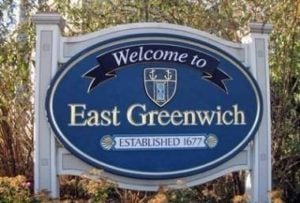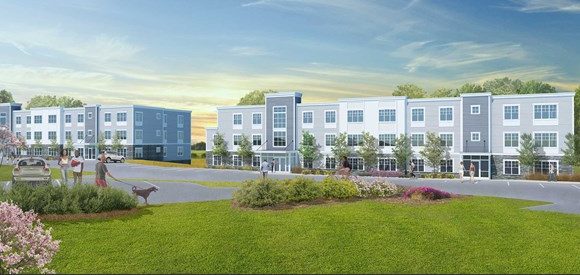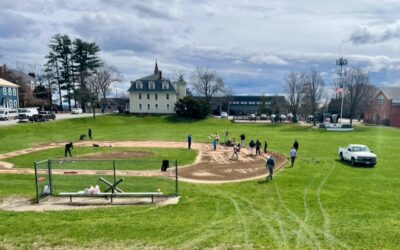 Unlike almost all other Rhode Island communities, East Greenwich is growing and that growth brings challenges and opportunities, members of both the Town Council and the Planning Board agreed at a recent joint session. Topics of discussion – “EG Considers Growth Management 2021” – included overcrowded schools, affordable housing development and diversity in the community, and what sorts of policy changes the town might make to promote “smart growth,” as Planning Board President Nate Ginsburg said. Find a list here: Growth Management Workshop.
Unlike almost all other Rhode Island communities, East Greenwich is growing and that growth brings challenges and opportunities, members of both the Town Council and the Planning Board agreed at a recent joint session. Topics of discussion – “EG Considers Growth Management 2021” – included overcrowded schools, affordable housing development and diversity in the community, and what sorts of policy changes the town might make to promote “smart growth,” as Planning Board President Nate Ginsburg said. Find a list here: Growth Management Workshop.
According to the town’s Planning Department, the average number of new dwellings built each year has increased by 50 percent since 2014, with 600 units of new housing currently under review. But even facing such a residential building boom, Ginsburg noted its difficult to predict town growth. The town’s most recent effort in that area – EG’s Comprehensive Community Plan (“comp plan” for short) – adopted in 2013 utterly failed to predict the current climate.
A comp plan is a roadmap of sorts to help guide the town in decisions on everything from transportation and recreation to natural resources and open space to housing and development. (You can find the town’s current comp plan, adopted in 2013, HERE.) The town must develop a new comp plan every 10 years, so that work is beginning now.
According to U.S. Census data, the town’s population only increased by 198 people (1.5 percent) between 2000 and 2010. Between 2006 and 2015, fewer than 20 new residential units were built annually and school enrollment was flat.
Then, everything changed.
“When I say we’re doing a 180-degree turn for my current comp plan I’m not exaggerating,” said Planning Director Lisa Bourbonnais. “As Mr. Ginsburg said, the current plan strikes a very poor development tone because our growth had been so flat to practically negative for several years and that’s just not the case anymore. So we need a bit of an about-face here, I think, to deal with the rate.”
In addition to 600 residential units that are either in the review or permitting process or under construction, this past fall, a developer presented a preliminary plan for 418 units on Division Road across from Westfield Drive. That particular proposal is not yet before the town and putting a shovel in the ground on that project – if it were to get all the approvals it needed – would be years off. Still, the specter of all this growth when every school in the district is at or over capacity has caused some officials to wonder if there are ways to slow things down.
Town Council Vice President Michael Donegan said rapid growth can impact everything from the sewer system, fire and police services, and – most significantly – schools. According to the Planning Board’s 2020 Annual Report, school enrollment has increased by 9.7 percent since 2016. With 600 more residential units, there are bound to be more children, although estimating numbers is a tricky game until actual people move in. And, smaller one- or two-bedroom units (such as in the 96-unit Brookside Terrace development on South County Trail) are potentially less inviting to families.

A rendering of Brookside Terrace at 1470 South County Trail. It is under construction now, with rental information here: https://www.rentcafe.com/apartments/ri/east-greenwich/brookside-terrace/default.aspx
Bourbonnais said growth management ordinances to limit the annual number of building permits could help control population growth and its impact on schools. However, since schools are already over capacity, she said she wasn’t sure it would help now. Another suggestion in the annual report was capping residential construction through a temporary moratorium. Or to encourage development of senior housing, of which there is anticipated to be an increasing need in coming years. Right now, around 21 percent of East Greenwich residents are 60 years or older (roughly 2,800 people). There are only 276 age-restricted units in town according to the report, and only 15 percent of the town’s housing stock are condos and small family units, which the report notes are common for senior citizens.
The town’s Municipal Land Trust has also already begun outreach to owners of underdeveloped land in town to recruit them to sell or donate their land to the town in exchange for tax benefits or other rewards, instead of selling the land off to a developer.
Not everyone at the meeting, however, thought growth was a bad idea.
During the public comment session, EG resident Susan Aitcheson, a member of the town’s Affordable Housing Commission and longtime affordable housing advocate, said, “We’re a town that’s hoarding our resources.”
She said that the town’s strategy of drawing veterans and senior citizens instead of investing in rental housing or family housing hurt the town’s diversity. She also argued a larger school system didn’t have to mean a lesser school system, citing Barrington’s school district, which is about double the size of EG’s.
“People want to live here and we’re growing,” Aitcheson said. “We need to take that and run with it. It is crazy talking about, ‘No, it’s going too fast,’ … We need racial and economic diversity. Housing is the best way to get racial and economic diversity. It will help the students in the school, will help the community and help the adults that live in East Greenwich.”
Aitcheson also explained that the history of housing in the town had prevented people of color from moving in by requiring things like 1-acre zoning to attract the wealthiest (and, by default, whitest) people to move in.
“You should have told [Brookside Terrace] you want three-bedroom units,” Aitcheson said. “But no, what did they do? One and twos, because you were concerned about the schools. That’s … stopping opportunity for other people.”
Brookside Terrace’s units are all going to be “affordable” under state law. Rhode Island set a target for municipalities to have 10 percent of their housing stock in that affordable category more than two decades ago. (The state defines affordable housing as dwellings where the “monthly costs would not exceed 30 percent of household income for a household with less than 120 percent of the county’s median income.”) Today, 4.7 percent of EG’s units are affordable and there are 138 additional affordable units under construction (including Brookside), which would up the town’s percentage to 7.7 percent, a significant jump but still below the target and that’s part of what’s been driving the recent development boom
Developers have been taking advantage of what’s known as a “comprehensive permit” process where if a project includes at least 25 percent affordable units, it can be fast-tracked by having the Planning Board weigh every aspect of a proposal. The alternative, depending on the project, could be multiple visits before town boards, a more time-consuming and expensive proposition. Because the town has not yet reached 10 percent affordable units, it is nearly impossible to reject these projects – if the town does reject one, the developer can appeal it to a state housing board whose entire mission is to promote affordable housing.
Affordable housing could lead to racial and economic diversity in town, said Planning Board member Matt Yoder.
“I think the one tool we have [to address diversity] is the affordable housing [mandate], and we’re most proud of it going towards seniors and veterans,” Yoder said. He noted the lack of any mention of diversity in planning documents and said town officials needed to step up. “We’re the town Planning [Board] and the Town Council – who else is going to work on that?”
Councilor Donegan said East Greenwich does not control who comes and builds, and that it is illegal to pass legislation that prioritizes certain racial groups. Councilor Renu Englehart said she agreed the town hadn’t planned for racial and economic diversity, but she expressed fear that more development would lead to higher taxes.
Donegan argued the town’s development history wasn’t motivated solely by race.
“There was no evil genius or great genius planning out the community of East Greenwich,” Donegan said. “What happened was East Greenwich was kind of a backwater that you had to get to by going [on] Post Road. And then Route 4 was built in the ‘80s so you can actually get here. It’s a waterfront community with a ton of land [and] in the go-go ‘80s the developers flocked here west of Route 2, and they just decided [what] the market was, and that’s how it all blew up.”
Town Manager Andy Nota said town residents needed to be involved in this process.
“Residents of EG have to contribute to this conversation and decide what they want the town to be,” he said. “We want to make sure the steps that we take in addressing some of our priorities don’t change the town we love so much it doesn’t exist anymore by the time we’re finished.”
“We need to spend a little bit of time thinking through some of the ramifications,” said Ginsburg, whose panel will take up these issues then return to discuss them further with the Town Council. “At the moment we don’t have the tools we need to have appropriate densities and to have smart construction and smart growth. I think this will help.”
You can watch the session HERE.






 Subscribe
Subscribe
The tone if this article angers me in that people are seeking to overwhelming the town w subordinate housing etc…why not get more industry and businesses to alleviate the longstanding inordinate tax burden on homeowners…btw more rentals will bring in mire people less concerned about the town and taxes because they r not directly affected…does eg even have an adequate industrial park…how about utilizing the empty bldgs along rte 2…eg has become and remains a community that overspend based on emotional issues if educ and public safety…fks that is not always financially sound…
The “evil genius” that made EG the white, wealthy town it is today was (and is) systemic racism. Let’s at least acknowledge that it permeates all discussions we’re having now. Phrases like that, and the comment here that claims “subordinate housing” and “more rentals will bring in mire people less concerned about the town and taxes” – that’s racism. Susan A. is right – embrace the growth and the opportunities it represents.
Affordable housing does bring diversity in all areas not just race into East Greenwich. It is also mandated by the state with fast-track application process through the Planning Board. Right now the town is dealing with an overwhelming amount of applications while also dealing with a financial burdens brought on by Covid. It is a fine line dealing with our current population while also planning for a future population and the services that they may need. My gripe would be that the state and GA need to help smaller municipalities like ours to reimburse us quickly and perhaps defray some of the costs up front. We cannot be reimbursed 1 or 2 years in arrears for children within the school system as well as some other costs that we may incur during a massive growth period. There was mention during the meeting that there are funds out there, but at this time our staff is already overwhelmed and developers are not always interested in discussing the long term costs of their projects. The Planning Dept’s report that is mentioned here is excellent and addresses some of the town’s concerns and some options. I commend both the dept and the Planning Board for their diligence on this. The comment by another commentator calling the housing “subordinate” is completely without merit and does nothing to address the issues of massive growth. Affordable housing in EG is not low income housing, to conflate the 2 is misleading at best.
Is there anything in the growth plan regarding energy and carbon emissions policy? The community seems rightly opposed to local energy generation in the form of waste plastic pyrolysis, but there needs to be an alternative approach. Shifting the burden of energy generation onto communities living around the state’s natural gas plants is inappropriate, both from a climate standpoint and from an environmental justice one. New development needs to be executed in a globally sustainable way, though this should not be used as an argument against more equitable development in general.
Johann – Those are great questions. The town is looking at energy aggregation and also more efficient lighting. Yet we are a small town with a lot of capital needs – many of which were put off for some time. We are in the unfortunate position of catching up those and trying to deal with future projects – which is part of our capital reserve initiative. The time this would require while also dealing with this boom of building applications and the basic business of the town which is also serving our current residents, the town has limited resources. However this is what the comprehensive town plan does – lay out a vision and guide the development of the town. What we are experiencing now is not something the town foresaw and creates further challenges for us. I know this is not the answer you want but all these items are interconnected and not easy to address quickly. This is something we should look at in the next comprehensive town plan which I believe is coming up in the next couple of years